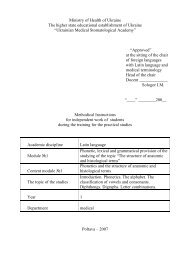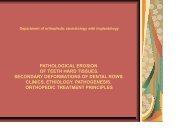Classification of posttraumatic complications of maxillofacial area ...
Classification of posttraumatic complications of maxillofacial area ...
Classification of posttraumatic complications of maxillofacial area ...
You also want an ePaper? Increase the reach of your titles
YUMPU automatically turns print PDFs into web optimized ePapers that Google loves.
<strong>Classification</strong> <strong>of</strong> <strong>posttraumatic</strong><br />
<strong>complications</strong> <strong>of</strong> maxill<strong>of</strong>acial <strong>area</strong>.<br />
Orthopedic methods <strong>of</strong> unreal joints<br />
treatment and breaks which not<br />
correctly accreted
Plan<br />
<br />
<br />
<br />
<strong>Classification</strong> <strong>of</strong> <strong>posttraumatic</strong><br />
<strong>complications</strong>.<br />
Clinics, diagnostics and methods <strong>of</strong><br />
orthopaedic treatment <strong>of</strong> breaks which<br />
are wrong accreted.<br />
Treatment <strong>of</strong> lower jaw breaks, which<br />
did not accrete (unreal joint).
Violation <strong>of</strong> correlation between dental<br />
rows can take place in vertical or<br />
horizontal plane, and in a number <strong>of</strong> cases<br />
there is displacement <strong>of</strong> wreckages in two<br />
mutually perpendicular planes. In<br />
accordance with it, there can be different<br />
types <strong>of</strong> pathological bite. Most <strong>of</strong>ten<br />
there is the open bite, rarer – cross bite<br />
and bite that goes down.
From data <strong>of</strong> different authors, breaks<br />
which accreted wrong, meet as<br />
complication <strong>of</strong> lower jaw breaks from 0,2<br />
to 14% cases: N.Michelson (1946),<br />
S.Vaysblat (1950) – 4-5%,<br />
B.Kabakov (1951) – 13,6%,<br />
D.Entin (1951) – 2%,<br />
Y.Bronstein (1951) – 0,2%.
According to a degree <strong>of</strong> occlusion<br />
contacts violation in a horizontal plane it is<br />
accepted to distinguish between three<br />
groups <strong>of</strong> patients:<br />
1. Occlusion contacts saved as a intercusp<br />
closing.<br />
2. Closing only by lateral surfaces (the<br />
cheek hillocks <strong>of</strong> lower jaw contact with<br />
palatal upper jaw).<br />
3. Complete absence <strong>of</strong> teeth closing.
V. Svyatykhin in his classification divides<br />
the non-union <strong>of</strong> lower jaw on:<br />
interposition;<br />
crack like;<br />
with the defect <strong>of</strong> bone 1-2 sm;<br />
with a presence or absence <strong>of</strong> teeth on<br />
one or both wreckages.
Reasons <strong>of</strong> formation <strong>of</strong> fake joints can be<br />
general and local factors.<br />
Diseases which reduce reactivity <strong>of</strong> organism<br />
and violate repairing processes in a bone are the<br />
general factors: tuberculosis, avitaminosis,<br />
dystrophy, vascular diseases, metabolic, illness<br />
<strong>of</strong> ductless glands disturbances.<br />
Local factors are the ill-timed setting <strong>of</strong><br />
wreckages, insufficient immobilization <strong>of</strong> them<br />
between wreckages, removing a layer by the<br />
layer <strong>of</strong> periostome on the large draught <strong>of</strong> jaw,<br />
traumatic osteomielitis <strong>of</strong> jaws which flow long-<br />
term.
<strong>Classification</strong><br />
<strong>of</strong> <strong>posttraumatic</strong> <strong>complications</strong><br />
All <strong>of</strong> the <strong>complications</strong> at the breaks <strong>of</strong><br />
jaws are divided into 3 groups:<br />
Direct<br />
Early<br />
Remote
<strong>Classification</strong><br />
<strong>of</strong> <strong>posttraumatic</strong> <strong>complications</strong><br />
It costs to accept as direct: asphyxia, bleeding, shock,<br />
primary disfigurement <strong>of</strong> a face, violation <strong>of</strong> language,<br />
mastication, swallowing.<br />
To early – consequences <strong>of</strong> vessels damage (to the<br />
hemorrhage), which grow insufficiency, consequences <strong>of</strong><br />
nerves damages (paresthesias, violations <strong>of</strong> innervation),<br />
syndrome <strong>of</strong> sharp disorder <strong>of</strong> water-electrolyte balance<br />
<strong>of</strong> organism.<br />
Remote or late breaks are treated as the second<br />
hemorrhages, to broncho-pulmonar disorder, traumatic<br />
osteomielitis, cysts, contractures <strong>of</strong> masetters, wrong<br />
accretion <strong>of</strong> wreckages, sialosyrinxs, unreal joint, scar<br />
deformations and second disfigurement <strong>of</strong> a face.
<strong>Classification</strong><br />
<strong>of</strong> <strong>posttraumatic</strong> <strong>complications</strong><br />
Direct (in place <strong>of</strong> event) and early (on the<br />
stage <strong>of</strong> evacuation or in medical<br />
establishment) <strong>complications</strong> fall into the<br />
category <strong>of</strong> critical conditions during which<br />
such physiology disorders take place, that<br />
it is impossible to correct spontaneously,<br />
for their removal partial or complete<br />
correction is needed.
<strong>Classification</strong><br />
<strong>of</strong> <strong>posttraumatic</strong> <strong>complications</strong><br />
Late <strong>complications</strong> develop as a result <strong>of</strong> 4<br />
principal reasons:<br />
heavy damages <strong>of</strong> maxill<strong>of</strong>acial <strong>area</strong> with defects<br />
<strong>of</strong> s<strong>of</strong>t and bone tissues;<br />
errors in providing <strong>of</strong> the specialized<br />
stomatological help to patient and at looking<br />
after them;<br />
decline <strong>of</strong> general organism reactivity ;<br />
rapid transformation <strong>of</strong> unpathogenic micr<strong>of</strong>lora<br />
<strong>of</strong> mouth cavity into high-virulent and<br />
pathogenic, stable to many antibiotics.
Clinics, diagnostics and methods<br />
<strong>of</strong> orthopedic treatment<br />
at wrong accretion <strong>of</strong> lower jaw fragments<br />
If at the damage <strong>of</strong> jaws a specialized help was done on<br />
time, the surgical roughing-out <strong>of</strong> wound, reposition and<br />
immobilization <strong>of</strong> fragments are correctly conducted, the<br />
process <strong>of</strong> healing flows favorably, anatomic integrity <strong>of</strong><br />
jaw gets better, correct occlusion <strong>of</strong> dental rows and<br />
function <strong>of</strong> cavity <strong>of</strong> mouth recommences.<br />
The tardy and unskilled granting <strong>of</strong> specialized help to<br />
the patients with the breaks <strong>of</strong> jaws results in accretion<br />
<strong>of</strong> fragments in wrong position, and wounds in s<strong>of</strong>t<br />
tissues with formation <strong>of</strong> rough scars, which limit<br />
motions <strong>of</strong> lower jaw, lips, cheeks, tongue.
Clinics, diagnostics and methods<br />
<strong>of</strong> orthopedic treatment<br />
at wrong accretion <strong>of</strong> lower jaw fragments<br />
Principal reasons <strong>of</strong> wrong accretion <strong>of</strong> lower jaw<br />
fragments are: inexact setting and weak fixing <strong>of</strong> bone<br />
fragments at their damage, and also late orthopedic<br />
interference. Such <strong>complications</strong>, as osteomielit,<br />
abscesses, phlegmons and other weaken regenerative<br />
processes in bone tissue, prolongs the terms <strong>of</strong><br />
treatment and assists the development <strong>of</strong> deformations<br />
Basic symptoms for diagnostics <strong>of</strong> wrong growing<br />
fragments <strong>of</strong> jaws are: asymmetry <strong>of</strong> a face, decrease <strong>of</strong><br />
dental arc length, turn <strong>of</strong> lower edge <strong>of</strong> lower jaw<br />
outside or inside, wrong inclination <strong>of</strong> teeth.
.<br />
Clinics, diagnostics and methods<br />
<strong>of</strong> orthopedic treatment<br />
at wrong accretion <strong>of</strong> lower jaw fragments<br />
Basic symptoms for diagnostics <strong>of</strong> wrong<br />
growing fragments <strong>of</strong> jaws are: asymmetry <strong>of</strong> a<br />
face, decrease <strong>of</strong> dental arc length, turn <strong>of</strong> lower<br />
edge <strong>of</strong> lower jaw outside or inside, wrong<br />
inclination <strong>of</strong> teeth.<br />
However, a most widespread symptom is the<br />
wrong closing <strong>of</strong> dental rows, during absence <strong>of</strong><br />
contacts between teeth by antagonists or to the<br />
presence <strong>of</strong> contacts only between separate<br />
teeth and groups <strong>of</strong> teeth. Original appearance<br />
<strong>of</strong> patient changes, occlusion contacts are<br />
violated.
The defect <strong>of</strong> bone, which is less than 2 sm,<br />
named as unreal joint, and over 2 sm – the<br />
defect <strong>of</strong> a bone.<br />
A clinical picture at the unreal joint <strong>of</strong> lower jaw<br />
is determined by the degree <strong>of</strong> fragments<br />
mobility, direction <strong>of</strong> their shift, position <strong>of</strong><br />
fragments in relation to each other and upper<br />
jaw, amount <strong>of</strong> teeth on fragments, state <strong>of</strong><br />
their paradontium, size <strong>of</strong> bone defect,<br />
localization <strong>of</strong> unreal joint, presence <strong>of</strong> mucous<br />
membrane scars and their sensitiveness.
I. M. Oxman defines four groups <strong>of</strong> unreal joints according to:<br />
localizations <strong>of</strong> damage,<br />
amount <strong>of</strong> teeth on fragments and the size <strong>of</strong> bone defect:<br />
Both fragments have 3-4 teeth<br />
– with the defect <strong>of</strong> bone up to 2 sm.<br />
– with the defect <strong>of</strong> bone more than 2 sm.<br />
Both fragments have 1-2 teeth<br />
Defects <strong>of</strong> lower jaw with toothless fragments:<br />
with one toothless fragment<br />
with both toothless fragments<br />
Bilateral defect <strong>of</strong> lower jaw:<br />
at the presence <strong>of</strong> teeth on a middle fragment, but at absence<br />
on lateral<br />
at the presence <strong>of</strong> teeth on lateral fragments, but absence on<br />
middle.
V. Kurlyandsky examines 3 groups <strong>of</strong> unreal<br />
joints:<br />
Non-united breaks within the limits <strong>of</strong> dental row<br />
at the presence <strong>of</strong> teeth on fragments.<br />
Non-united breaks within the limits <strong>of</strong> dental row<br />
at the presence <strong>of</strong> toothless fragments.<br />
Non-united breaks behind dental row.<br />
Formation <strong>of</strong> unreal joint couses violation <strong>of</strong> a<br />
biting and chewing <strong>of</strong> meal, swallowing and<br />
speech.
Treatment<br />
<br />
<br />
The best functional effect at unreal joints gives bone plate<br />
with future prosthetics <strong>of</strong> dental row defects. Prosthetics<br />
without proceeding in integrity <strong>of</strong> bone is recommended to<br />
conduct when the operation <strong>of</strong> plastic is not indicated or it is<br />
put aside for a long time (exhaustion <strong>of</strong> organism, flat refusal<br />
<strong>of</strong> patient from operation). In these cases prosthetics carries<br />
temporal character with the purpose <strong>of</strong> correct position<br />
maintenance <strong>of</strong> jaw fragments and firmness that remained<br />
before the moment <strong>of</strong> possible bone plastics.<br />
Basic principle <strong>of</strong> prosthetics is that the parts <strong>of</strong><br />
prosthetic appliance are disposed on jaw fragments, are<br />
connect motionlessly so that they do not hinder the shift <strong>of</strong><br />
fragments. Substituting <strong>of</strong> dental row defects for patients with<br />
the non-united breaks <strong>of</strong> lower jaw with ordinary prosthetic<br />
appliances will result in the functional overload <strong>of</strong> teeth.

















